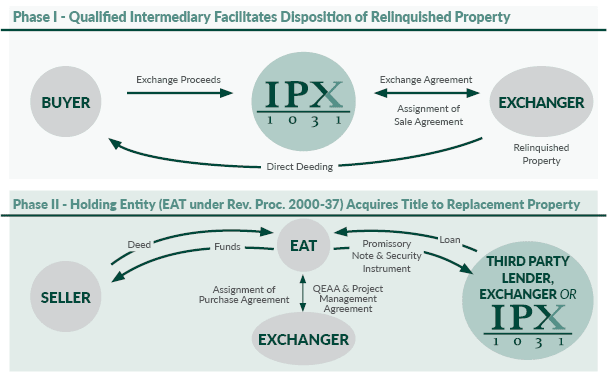The Build to Suit Exchange


If you are planning on purchasing property to complete your 1031 Exchange that requires improvements or perhaps you need to purchase land and construct a building, a Build-to-Suit Exchange may be your best strategy.
What is a Build-to-Suit Exchange?
Steps for Build-to-Suit Exchange
As part of the transaction, the Exchanger will sell the Relinquished Property through a Qualified Intermediary in a traditional Delayed Exchange. This step generally comes first, but in some situations the Replacement Property is acquired first through a parking arrangement. Prior to closing on the Replacement Property, the Exchanger must enter into a Qualified Exchange Accommodation Agreement (QEAA) with an Exchange Accommodation Titleholder (EAT) and assign its rights in the purchase contract to the EAT. The EAT then acquires (parks) the Replacement Property, using Exchange Funds, money from the Exchanger or a bank loan.The use of an EAT to park title to the Replacement Property is necessary because (1) Section 1031 does not permit the Exchanger to own both the Relinquished and Replacement Properties at the same time; and (2) Exchange Funds cannot be used to improve property that the Exchanger already owns.Timing in a Build-to-Suit Exchange
Managing the statutory time limits can be a little tricky. In the Delayed Exchange the Replacement Property must be identified within 45 days of the Relinquished Property sale and acquired by the Exchanger within 180 days. Pursuant to Rev. Proc. 2000-37 the EAT cannot hold the Replacement Property for more than 180 days.If the Relinquished Property is sold first, that 180-day time limit will control. The Exchanger must acquire the parked Replacement Property by day 180 after the sale, even if the 180-day time limit for the parked property still has time to run.Identifying Property in a Build-to-Suit Exchange
Unlike a Delayed Exchange, when it is part of a Build-to-Suit Exchange the identification of the Replacement Property must include not only a description of the underlying real estate, but also as much detail regarding the intended improvements as is practical.How to Fully Defer Taxes in a Build-to-Suit Exchange
To fully defer taxes and avoid boot, at the time the Exchanger takes title the Replacement Property must have a value equal to or greater than the value of the Relinquished Property and all the exchange equity must have been invested. Any unused Exchange Funds may be taxable as boot. Only funds disbursed for material actually in place and services actually performed will count toward the exchange value. Improvements made to the Replacement Property after the Exchanger takes title cannot be included in the exchange value. Exchange Funds placed in escrow for post-closing improvements will not qualify even if the funds are deposited before the Exchanger takes title.Who Manages a Build-to-Suit Exchange?
The Exchanger or its designated representative will act as the Project Manager to oversee all aspects of the construction, including sending invoices to the EAT for payment. The EAT must make payments directly to the vendors. During the exchange period the Exchanger cannot be reimbursed for any expenses it incurs or advances.If the Exchange Funds are not sufficient to complete the acquisition and improvement of the Replacement Property, additional funds can be loaned to the EAT by the Exchanger. If a loan from an institutional lender is required, the Exchanger should seek lender approval prior to beginning the exchange. Some lenders will not allow the EAT to be the borrower on the loan. The EAT will require the loan be non-recourse as to itself. Lenders typically require the Exchanger to guarantee a loan made to the EAT.At the end of the Exchange, the Replacement Property is often transferred to the Exchanger by assignment of the sole membership interest in the holding entity rather than by a deed. Selecting the appropriate method for transfer of title should be determined after review of transfer tax and other legal issues by the Exchanger’s tax and legal advisors. If a third-party lender is involved, the Exchanger will assume the loan upon the conclusion of the exchange.Is a Build-to-Suit Exchange for Me?
A Build-to-Suit Exchange is an excellent way to utilize tax deferred dollars to build exchange value. Because construction timelines can be difficult to control, this type of 1031 Exchange requires careful planning. Please contact one of the Exchange Experts at IPX1031 to set up your next Build-to-Suit Exchange.IPX1031 – Your Build-to-Suit 1031 Exchange Solution
Regardless of the type of 1031 Exchange you need, our IPX1031 specialists are standing by to help make your transaction a smooth process. For more details, read Planning Ahead for a Successful Exchange and How to Initiate a Reverse Exchange. As with all investments and wealth maintaining strategies, you should seek the advice of your own legal and tax advisors for your specific situation. IPX1031 is the largest national qualified intermediary providing a full suite of services. IPX1031 also has the largest and most experienced Reverse and Improvement Exchange division in the country specializing in transactions REITS, life insurance companies, businesses, and individual investors. Contact IPX1031 to discuss your 1031 Exchange solution.